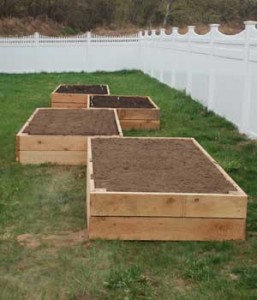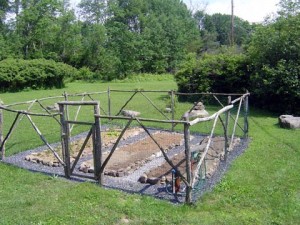Raised Bed Vegetable Gardens
 Raised Bed Gardens
Raised Bed Gardens
We are planning on finally planting a garden this year at our new house. This year will be our 3rd full summer so we really want to get some vegetables going as we miss having our own garden. We had a medium size vegetable garden at our first home and we grew tomatoes, cucumbers, lettuce, green beans and squash.
I’ve seen lots of great looking and functional raised bed vegetable gardens so we’ve decided that we’re going to try building some. One of the reasons I want to use raised bed gardens is due to the slope of our back yard. I’m planning on planting the garden on a gradual slope. By using a raised bed I can create a level planting area that will allow me to water the garden without losing most of the water to the slope.
Photo Credit: Raised Bed Vegetable Garden
Benefits of Raised Bed Gardens
Raised Bed Vegetable Gardens have several benefits in addition to looking nice
- Soil – By creating a raised bed garden I’ll have to bring in soil to fill it. This means I have a perfect chance to use good quality soil from the beginning.
- Drainage – Raised bed gardens help ensure that your garden soil doesn’t become too saturated. Whether you leave the hose on too long or a down pour inundates your garden, the higher elevation will allow excess water to drain away.
- Access – Obviously a raised bed garden is much easier to access. You won’t have to bend over as far so weeding and picking should be much easier on your back. The raised bed is also a great way to keep foot traffic out of your garden so plants aren’t damaged.
Building Raised Bed Gardens
Building raised bed gardens isn’t very difficult. There are many different styles and materials that can be used. In the photo you can see a raised garden bed that Paul over at Homeowner’s Blog made last summer. He used stones to create his raised beds and they look really great.
Most people end up building raised bed gardens with some type of wood, typically cedar or a similar rot resistant lumber. Most experts say to avoid using pressure treated lumber to avoid any contact with harmful chemicals (I’m not really sure it’s that big of a deal). You can also buy raised bed kits made from plastic and wood. There are also some really good raised bed gardening books available with ideas and layouts.
Most likely I’ll build one medium sized raised bed garden. Most likely it will be 8 ft wide and 24 ft long. I haven’t decided what type of material I want to use yet. I’m considering using wood or some type of lanscape blocks. I suppose it will ultimately come down to cost and availability of materials.














I haven’t built any yet myself, but I hear 4′ wide is the way to go so that you can easily reach the whole bed from the sides. So instead of 8×24, two at 4×24 would probably be a better bet, although it will use more materials for the sides.
@ Gene – Good point….I was hoping create two rows, one for each side…..guess I need to think about that a bit more.
I made my beds about 4 foot wide, which seems to work very well. It is just right for reaching into the center of that tomato plant and pulling of a nice red fruit. Any further and you would likely have to step up onto the bed to pick vegetables.
@ Paul – I think you guys have convinced me of 4′. I’m really struggling on what material to use. I hate to spend the money on cedar….I’ll need to make a decision shortly!
I’ve been planning raised vegetable beds for years now… with stone instead of wood, as we have a LOT of free stone.
What vegetable would you think are most suitable for this type of garden? Or what might “not” be a good idea to put in? Also, I am going with a 12″ depth, any comments. Thanks
I think all vegetables will work well. I think most vegetables have roots that only go a few inches down.
I am looking at using 2″ x 12″ x 12 ft cedar and attach either with corner brackets or 4″ x 4″ in the corners. How do I keep the sides from bowing on a 12foot side?
To keep the sides from bowing you need to stake the sides or secure a length of wood (strongback)on the sides. Running the full length and fasten with long “deck” screws.
@ Phil – You are correct, I installed stakes at the center as well, just didn’t show them in the sketch.
If you like going “green”, recycling and the like, consider using used treated lumber. I’ve found there are pleny of deck builders who tear off and rebuild decks who are more than happy to donate used 2x material. It is free and you are pulling it right out of the waste stream. There are more nails and more sorting to do however.